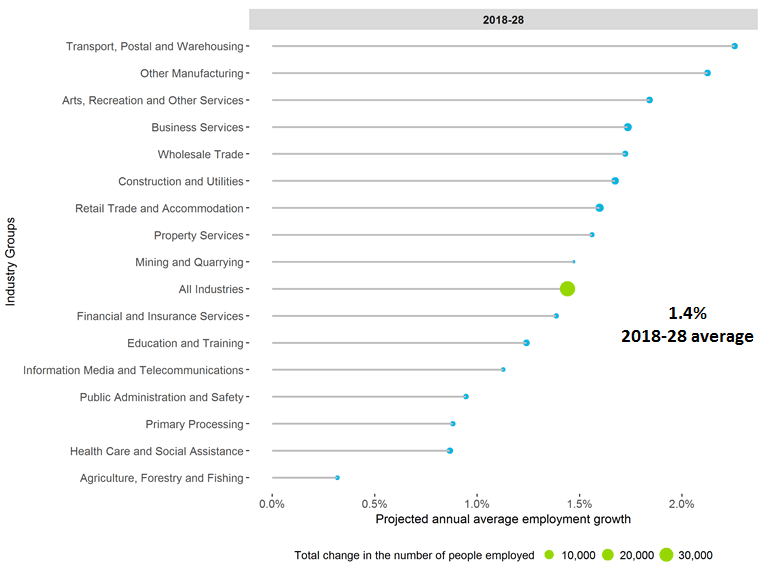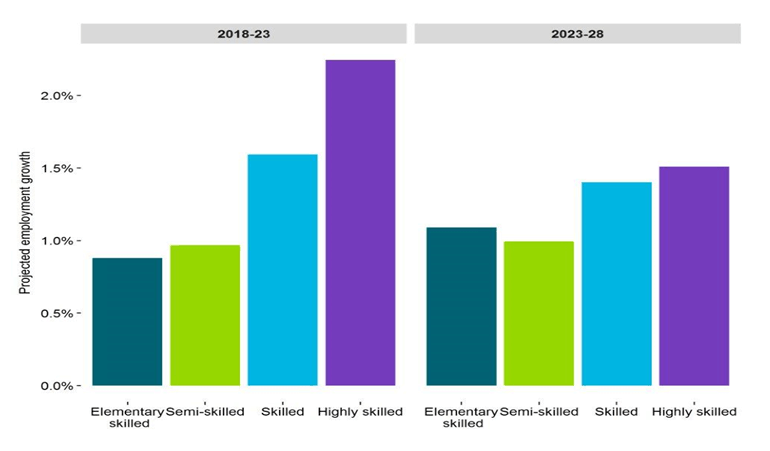Medium to long-term employment outlook: Looking ahead to 2028
This report presents our employment projections by industries, broad occupation and skill groups to 2028.
On this page
Medium to long-term employment outlook: Looking ahead to 2028 [PDF, 1.7 MB]
This report updates the Ministry’s medium to long-term outlook released in 2018. It presents employment projections by industries, broad occupation and skill groups to 2028.
The employment outlook to 2028 informs the Ministry’s medium-long term policy advice in a number of areas including those related to immigration policy and operational settings. The Occupation Outlook 2019, used by high school students and adults in making career choices, also refers to this employment outlook.
These projections are based on a Computable General Equilibrium model developed by the Business and Economic Research Ltd (BERL) for use by the Ministry of Business, Innovation and Employment (MBIE). The method and underpinning assumptions are described in the methodology section of the report.
Key points
- 39, 400 more workers on average each year to 2028. Employment is projected to grow by 1.4 per cent annually, adding 39, 400 workers on average per year to the workforce in the 10 years to 2028.
- Steady economic growth supports this employment growth — average annual GDP growth of about 2.7 per cent and 2.5 per cent over the 2018-23 and 2023-28 periods, respectively.
- Retail trade, Accommodation & Food services, Business services and Construction are forecast to have the strongest employment gains. These three broad industries together are projected to add around 17,500 more workers per year on average to employment growth in the ten years to 2028.
- 22, 800 average annual increase in demand for highly-skilled occupations. Employment growth will be strongest for highly-skilled occupations, and weakest for elementary-skilled occupations (4, 100 annually) over the forecast period.
In the medium-term, steady employment growth is anticipated across a range of industries matched by labour supply from continuing positive net migration levels and from domestic sources. In the long-term, increasing labour supply constraints arising from an ageing population is anticipated to result in higher productivity growth.
The employment projections are based on GDP growth and other macroeconomic forecasts and productivity assumptions at the industry level, and are indicative of the likely growth path of employment. Because a top-down macroeconomic approach was used to project employment changes by industry, care should be taken when interpreting specific employment projections.
In order to capture some of the uncertainty with these projections in the medium term (2018-23) with respect to the current international trade environment and in the long term (2018-28) with the impacts of automation on the New Zealand workforce, two alternate scenarios have been modelled and the results are included in this updated report (Please see the PDF version for more details).
Industry
A number of industries across privates services will drive employment growth
Nine out of the 16 aggregated industry groups will have higher than average annual growth over the 10 years to 2028. Of these industry groups, Transport, postal and warehousing (logistics) will have the strongest annual growth rate (2.3 per cent but only 2,700 additional employment per year as it is a small sector), followed by ‘Other manufacturing’ (2.1 per cent or 3,200 more employment per year) which are those not related to the processing of primary products.
In terms of the size of the employment growth, it will be higher in Business services (6,100 more employment per year or 1.7 per cent), Retail trade and accommodation (6,600 more employment per year or 1.7 per cent), and Construction and utilities (4,800 more employment or 1.7 per cent). Strong growth in household spending, residential investment and tourism will underpin this growth. Strong growth in exports over the projection period will also support employment growth.
Over the forecast period, employment growth will be weakest in the primary sector. Weak to modest growth is projected in primary processing and the public sector related to public administration and safety.
Figure 1: Fastest to slow growing industry groups over the ten years to 2028

The data table for Figure 1 and the full data table for 28 industries is available at the bottom of this page.
Occupation
22, 800 average annual increase for highly-skilled occupations
Employment growth will be strongest for highly-skilled occupations, including managers and professionals, which are projected to account about 58 per cent of the total employment growth in the ten years to 2028. Within the highly-skilled occupation group, annual growth with be fastest for advertising, public relations and sales managers and ICT managers. Over the forecast period, employment in highly-skilled occupations will increase by 228, 000.
4, 100 more elementary-skilled workers on average each year
Opportunities for elementary-skilled workers will be fewer, with annual growth of 1.0 per cent over the ten years to 2028. The fastest growing occupations are drivers, construction and mining labourers and delivery drivers. These occupations will make up about 35 per cent of the 41, 400 increase in employment for this group.
Figure 2: Annual average percentage change, skill group, 2018-23 and 2023-28 periods

The data table for Figure 2 and the full data table for 97 occupations is available at the bottom of this page.
Data tables
Data table for Figure 1
Data table 1: All 28 industries
Data table for Figure 2
Data table 2: All 97 occupations

